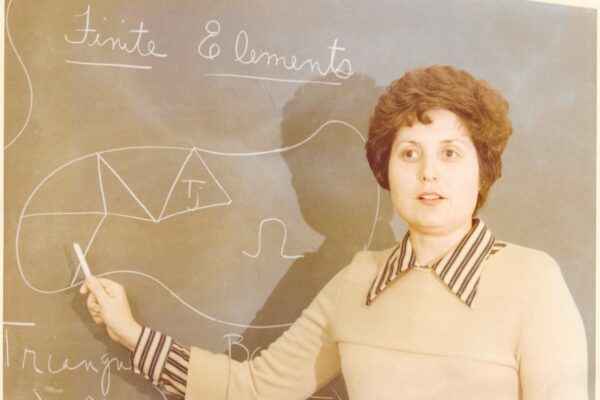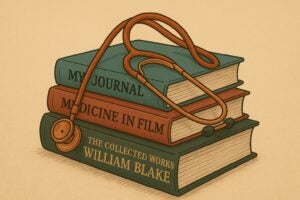After an illustrious career spanning more than five decades in applied mathematics, computational science and petroleum engineering, Mary F. Wheeler has retired from The University of Texas at Austin. In a male-dominated field, Wheeler’s research in numerical simulation of partial differential equations and modeling in porous media — groundwater, biomedical, carbon storage — has been ground-breaking.
Sifting through stacks of books and research papers in her office, Wheeler recalled fond memories of her earlier years when she worked alongside many of the greats in computational sciences. “I’ve had a wonderful, exciting career here. It was the golden age of finite element methods. I’m very fortunate,” said Wheeler, who has spent the last 30 years of her career at the Oden Institute for Computational Engineering and Sciences and as a professor in aerospace engineering and engineering mechanics at UT’s Cockrell School of Engineering.

The names of her colleagues are a who’s who of computational engineering: J. Tinsley Oden, Ivo Babuška, Graham F. Carey, Henry Rachford, Todd Dupont, Roland Glowinski, David Young, Thomas J. R. Hughes and Don Peaceman.
Though she hailed from Cuero, a small South Texas town known for its wide-open skies, ranching and turkeys, for Wheeler, who grew up surrounded by strong, educated women, there was never a doubt she would go to college.
Wheeler attended UT, initially pursing pharmacy, then government, but mathematics was calling her name. She took one course and was hooked, forever altering the trajectory of her career. Wheeler graduated with a dual bachelor’s degree in social sciences and mathematics and subsequently earned her master’s degree in mathematics.
Along the way, she met her soon-to-be husband, John. They married in 1963. John was a Ph.D. chemical engineer who was recruited by Houston-based Humble Research/ Humble Oil and Refining Co., a precursor to the company now known as Exxon, and the couple moved to Houston.
For Wheeler, the proximity to Rice University presented a new opportunity. She intuited that her master’s thesis on the Peaceman-Rachford Method could serve as an introduction to Rice professor Henry Rachford and the Ph.D program. Her gamble paid off, and she started the next chapter in her education. Rachford, Jim Douglas Jr. and Don Peaceman were considered to be the early fathers of modern reservoir engineering. Wheeler quickly dove in.
“I worked for Henry and realized I liked the subsurface flow problems,” she said. “My heart is in environmental applications: bioremediation, carbon storage, geothermal, compositional flows and hydraulic fracking.” Wheeler earned her Ph.D. in mathematics from Rice University. She noted that fracking, often in the news, isn’t a new concept, and dates back to the 1940s.
“Her Ph.D. dissertation gave us the elliptic projection, a major theoretical tool used to understand the accuracy of time dependent parabolic problems,” said Todd Arbogast, associate director for the Center for Subsurface Modeling at the Oden Institute and mathematics professor at UT. “From early in her career, Mary advocated for the adoption of finite elements and related technologies in subsurface applications. She was the driving force behind the development of many important algorithms that have entered into simulation technologies,” he added.
At Rice University, Wheeler was the first tenured female associate and full professor in engineering and ultimately the first woman to hold the Noah Harding Professor of Computational and Applied Mathematics.
In 1995, her alma mater came knocking, offering an opportunity too good to pass up. Wheeler accepted the position at UT at what is now known as the Oden Institute, (renamed after J. Tinsley Oden in 2019) and began the Center for Subsurface Modeling. At Texas, Wheeler’s career came full circle when she collaborated with greats in the field she admired early in her career: Oden, Carey, and Babuška.
“Some of those early ideas Graham Carey and I worked on are now coming to fruition. More recently, with my graduate student Ahmed Almetwally, we are finding that Carey’s adaptivity approach allows us to address very difficult geothermal modeling accurately at UtahFORGE. It is amazing that, through Carey’s students, we are still working together.” Utah FORGE, where Wheeler has UT grants, is a dedicated underground field laboratory for developing, testing and accelerating breakthroughs in geothermal resources.
Arbogast said Wheeler was the driving force behind the development of many important algorithms that have entered into simulation technologies by proving their theoretical properties.
“She advocated that mixed methods be used to solve flow problems. The petroleum industry tended to use cell-centered finite differences, which could not be proven to be accurate. Mary was able to not only prove that they were accurate, but that they were simple approximations to a mixed method. She was a pioneer in developing and analyzing both characteristic methods and discontinuous Galerkin (DG) methods for flow and transport problems long before they became popular in computational mechanics. The importance of her DG work cannot be understated, as it was truly transformative.”
Subsurface modeling remains the core of her research. Wheeler is currently working on six papers spanning topics in fracture mechanics, geothermal, carbon storage and porous media, reminding us that, in a world where greenhouse gasses and a warming environment are fast becoming the norm, her work seeking solutions to grand challenge problems is vital.
With over 400 papers written, two honorary doctorates, and a long list of accomplishments, Wheeler said “I’ve had such a good time that’s why I keep going.” She commented that she didn’t get to this pinnacle in her career alone. “My accomplishments also belong to the 48 doctoral students and 43 postdoctoral fellows, and 8 master students I have supervised.”
In 2023, the Mary F. Wheeler medal was established by the United States Association for Computational Mechanics (USACM), with the first medal to be awarded in 2025. Wheeler is a member of the National Academy of Engineering, recipient of the Theodore von Kármán prize Society for Industrial and Applied Mathematics (SIAM), member of the American Academy of Arts and Sciences, received the John von Neumann Medal award from the USACM. She is the proud recipient of the prestigious Joe J. King Professional Achievement Award from The University of Texas at Austin in 2006.
In addition, Wheeler was instrumental in forming the SIAM Geosciences Activity Group with its series of biennial international conferences, and she founded the Computational Geosciences journal to promote research in subsurface modeling world-wide.
“Mary is a pioneer, a powerhouse, and a computational science legend. We will miss her greatly,” said Karen Willcox, director of the Oden Institute.
Wheeler has often said that ‘while it’s interesting to do a problem, it’s exciting to see how math is applied in real time.‘ “Seeing how computational simulations match with real life experiments is rewarding.”
Thinking about the future, she said prospects coming down the pipeline are intriguing, noting the importance of partnering with industry. “There must be new developments. This is where computation plays such an important role along with working with a critical, interdisciplinary group on applications from carbon storage, thermal energy to ideas in predictive surgery – it’s like going to a candy store – there are so many opportunities on the horizon.”

According to Arbogast, Mary’s most recent work on geomechanics is among the best work of her career. “She developed mathematical techniques to analyze and improve simulation of the problem. She went further by introducing phase field modeling to simulate crack propagation, which is when cracks form and extend or propagate in rocks within the Earth’s subsurface.”
While she was steeped in academia and research that has improved methods in petroleum engineering, simultaneously, that small town that shaped her formidable years grew beyond its ranching roots and is now known for its oil and gas production.
Staying true to her Texas roots, Wheeler has combined her love of the environment with the economic realities of the Texas oil and gas industry. Her research to develop methods for cleaning up underground contamination, such as petroleum leaks, and finding innovative ways to store carbon, have provided guidance to scientists for remediation.
Professor Emeritus Wheeler said her legacy is simple: applying finite element methods to subsurface problems and really looking at Multiphysics problems. “When I first started in computational modeling, I never dreamed I would look at such problems as I have over the course of my career. It’s always been about how to put all the pieces together. All these processes occur at different scales but there is a common bond between them. There’s still work to be done. I have a little left to give.”




